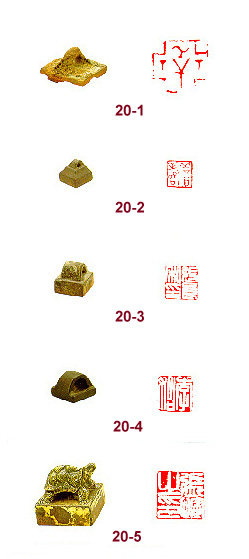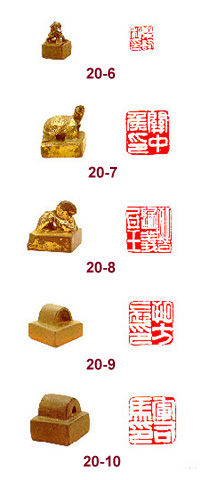Bronze Seal
 20-1 Bronze seal cast with "Ya Ch'in" (Central Museum) Pierced knob
Late Shang dynasty (13th--11 th cent. B.C.)
20-1 Bronze seal cast with "Ya Ch'in" (Central Museum) Pierced knob
Late Shang dynasty (13th--11 th cent. B.C.)
The semi-circular shape and thin body are both representative of early seals, making this a forerunner of later senerations. The seal is made up of the characters ch 'in, shih, and ya and belonged to the late Shang dynasty house of Ch'in.
20-2. Bronze seal cast with "Shan Shou" (shu-6)
Altar-shaped knob
Warring States period (475--221 B.C.)
Two characters are cast in slender relief lines inside of a frame. In Western Chou dynasty (11th cent.-770 B.C.) bronze inscriptions, the character, shan is made up of two yen characters and a yang character, but into the Warring States period, one was deleted and the was simplified. In classical Chinese, the word meant both beauty and good fortune. The combination "shou" was a customary auspicious seal during the Warring States period.
20-3. Bronze seal cast with "Chang Liang Ssu Yin" (t'u-4)
Tile-shaped knob
Western Han dynasty (221 B.C.--A.D.9)
This seal has a thick body and a tile-shaped knob. The unframed characters are cast in intaglio. There was a Chang Liang (style name Tzu-fang) during the early Han dynasty, who was instrumental in the Han dynasty emperor Kao-tsung's defeat of the Ch'u king Hsiang-yu and the securing of the Han dynasty and who was subsequently enfeoffed as Lord Liu. It is possible that this seal belonged to him.
 20-4. Bronze seal cast with "Li Shih" (pi-5)
20-4. Bronze seal cast with "Li Shih" (pi-5)
Arch bridge-shaped knob
Han dynasty (221 B.C.--A.D. 220)
This seat has a thin body with a depressed center. The two unframed characters are cast in intaglio, with simple, straightforward strokes, a style representative of Han dynasty seals.
20-5. Bronze seal cast with "Chang Yun Chih Yin" (yu-3)
Tortoise-shaped knob, gilt
Hsin dynasty (A.D. 9--23)
The tortoise body is carved in fine detail with even the scales readily apparent. The tortoise's legs stand in each of the four corners of the seal and, together with a downturned tail, make five points of support. This life-like style, including a forward leaning stance, is characteristic of tortoise-shaped seal knobs of the Hsin dynasty.
20-6. Bronze seal cast with "Le Lung Ssu Yin" (t'u-6)
Auspicious animal-shaped knob, gilt
Eastern Han dynasty (A.D. 24--220)
This seal was originally plated with gold, but most of the gold has already peeled away. With a large head and strong body, the beast-shaped knob was meant to be a talisman against evil. The head of the beast is canted to one side, its cheeks are covered with whiskers, its legs are upright and stalky, and its tail drags on the ground to the left. All of these features give the beast an imposing and forceful air. The four characters of the seal are unframed and cast in intaglio.
20-7. Bronze seal cast with "Kuan Chung Hou Yin" (tung-5)
Tortoise-shaped knob, gilt
Wei-Chin period (A.D. 220--420)
With up-raised head and thick neck, this intricately carved tortoise is a hallmark of seals from the Wei-Chin period. The four characters cast in intaglio are the mark of Lord Kuan Chung. Lord Kuan Chung, an unlanded degree of nobility, originated during the Wei dynasty and was conferred for outstanding military achievements. During the Western Chin dynasty (265--316), the emperor went against customary practices and granted land to the holder of this title.
20-8. Bronze seal cast with "Chin Kuei I Ti Wang" (pi-3)
Camel-shaped knob, gilt
Chin dynasty (A.D. 265--420)
The knob of this seal is in the shape of a simplified camel, and the five characters are cast in intaglio. Beginning with the Wei dynasty (220--265), the Ti tribe became a vassal state of China. During the Chin dynasty, it grew gradually stronger, and in the Northern and Southern dynasties period (386--589) it maintained a powerful position in the land. At that time, kings of foreign tribes were given seals plated with gold as a demonstration of the emperor's high respect for them. One corner of this seal has been chopped away, possibly indicating that it was intentionally nullified upon the death of the king.
20-9. Bronze seal cast with "Shuo Fang Chang Yin" (yu-2)
Tile-shaped knob
Han dynasty (221 B.C.- A.D. 220)
The four characters on this seal are cast in intaglio. "Shuo Fang" refers to a region dubbed Shuofang prefecture after Emperor Wu-ti (140 -- 86 B.C.) of the Han dynasty expelled the Huns. "Chang" can be translated as county magistrate, referring the leader of a county (in this case Shuofang county) of fewer than 10,000 households. Shuofang prefecture stood in the present-day Ordos region of Inner Mongolia, or that part of present-day Suiyuan province which lies south of the Yellow River. Shuofang county is now known as Ordos B. G. H.
20-10. Bronze seal cast with "Chun Ssu Ma Yin" (tung-2)
Tile shaped knob
Eastern Hart dynasty (A.D. 24-220)
With bold, powerful strokes, the four characters on this seal are cast in intaglio. The military position chun-ssu-ma was a rank above a chun-ch'u-hou and a rank below a pu-ch'u-chiang.
Please use [BACK] function key return to previous page
 20-1 Bronze seal cast with "Ya Ch'in" (Central Museum) Pierced knob
Late Shang dynasty (13th--11 th cent. B.C.)
20-1 Bronze seal cast with "Ya Ch'in" (Central Museum) Pierced knob
Late Shang dynasty (13th--11 th cent. B.C.)  20-4. Bronze seal cast with "Li Shih" (pi-5)
20-4. Bronze seal cast with "Li Shih" (pi-5)